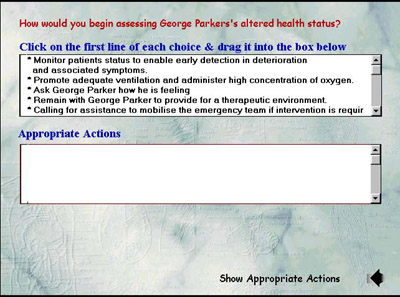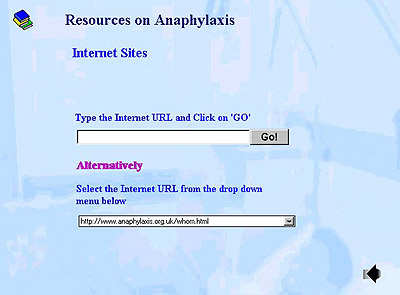| 1. | Educational Problem | ||||||||||||||||||||
| 2. | Conceptual Design | ||||||||||||||||||||
| 3. | Design Architecture | ||||||||||||||||||||
|
|||||||||||||||||||||
| 4. | Procedure | ||||||||||||||||||||
| 5. | Development | ||||||||||||||||||||
| 6. | Evaluation | ||||||||||||||||||||
| 7. | References | ||||||||||||||||||||
| 8. | Acknowledgments |
| Appendix |
| Printer-friendly version |
![]()
Approaching Clinical Decision Making in Nursing Practice with Interactive Multimedia and Case-Based Reasoning
Som Naidu, The University of Melbourne
Mary Oliver, The University of Southern Queensland
Andy Koronios, The University of Southern Queensland
Abstract
This paper describes the conceptual design,
development and formative evaluation of a self-paced multimedia learning
resource that is intended to facilitate clinical decision making in nursing
practice with case-based reasoning. With the help of a contrived situation,
the resource attempts to simulate the complexities of life in a typical
hospital ward, which places graduating nurses in the role of problem-solvers.
Problem solving in the simulation is based on a rich repertoire of cases
and stories that have been extracted from the experiences of expert practitioners.
This case-based reasoning architecture reflects a model of learning where
graduating nurses are coached in the development of decision-making skills
within the context of a contrived but an authentic problem. Formative
evaluation of this multimedia resource using structured and open-ended
question types has been carried out with individual and small groups of
practicing nurses. Their general impressions of this resource, and especially
its approach to learning, have been positive. More extensive evaluation
of the resource is currently in progress.
1. Educational
Problem
In much
of Australia (and very likely elsewhere), approaches to the preparation
of nursing students for a successful transition into the workplace has
been found to be ineffective. Recognizing that more of the same kind of
support was not going to be useful, we argued for a radical shift in helping
graduating nurses to make the transition into the workplace. Our proposition
combines powerful educational technologies and proven learning strategies
to build a self-paced technology-enhanced learning environment. Governments,
health care organisations and nurse educators have also suggested that
in order to prepare better nursing graduates for the challenges of the
workplace, there must be alternative ways of preparing graduating nurses
for the demands of clinical decision making in situ. An obvious
improvement would be increased collaboration between the employing organizations
and nursing education institutions to provide realistic learning situations
outside the formal classroom, and offered in a self-paced and self-instructional
environment. These alternative learning opportunities would need to be
solidly grounded in the authentic problems and situations of the nursesí
daily routines. The learning tasks would need to be immediately relevant
and meaningful to them, and not too removed from their workplace environment.



